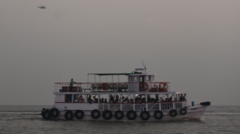Thirteen people were killed, including three navy personnel, after a naval speedboat collided with a ferry near Mumbai. Over 100 people were rescued from the capsized vessel, prompting concerns about safety measures and accountability within the naval forces.
Collision at Sea: 13 Casualties in Mumbai Ferry Disaster

Collision at Sea: 13 Casualties in Mumbai Ferry Disaster
An Indian naval speedboat collided with a passenger ferry, leading to significant loss of life and raising questions about maritime safety protocols.
At least 13 individuals lost their lives after a naval speedboat collided with a passenger ferry off Mumbai, creating a tragic maritime incident that has sparked discussions about safety regulations in Indian waters. The speedboat, operated by the Indian Navy, reportedly experienced an "engine malfunction," leading it to lose control before crashing into the privately owned ferry, which was ferrying tourists to the Elephanta Caves, a well-known tourist attraction.
Among the deceased are three navy personnel, as confirmed by Maharashtra state chief minister Devendra Fadnavis. More than 100 passengers were rescued from the sea following the capsize of the ferry, which was struck by the speeding naval craft. Eyewitness accounts highlight the chaos that ensued, with passengers recalling the rapid influx of water as the ferry began to overturn.
Prime Minister Narendra Modi expressed condolences to the victims' families and encouraged a swift recovery for the injured. "The boat mishap in Mumbai is saddening," he stated, reflecting the national sentiment toward the catastrophic event.
As investigations unfold, the incident underscores the importance of adhering to maritime safety standards and the need for accountability in the operations of naval vessels, particularly when in close proximity to civilian watercraft. The Indian Navy's statement regarding the engine trial emphasizes the delicate balance required for training exercises to not jeopardize public safety.



















